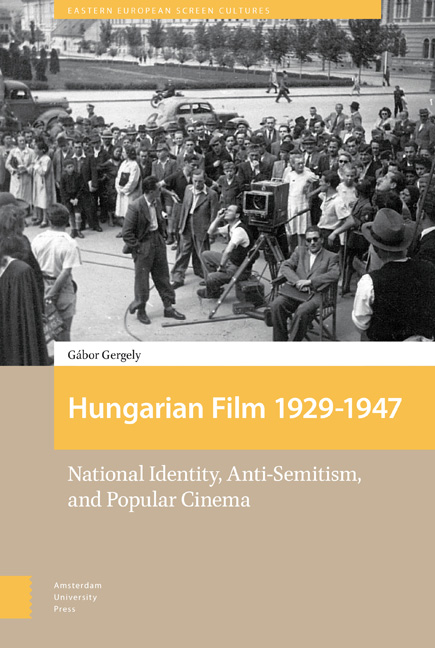Book contents
- Frontmatter
- Dedication
- Contents
- List of Illustrations
- Acknowledgements
- A Note on Accents, Pronunciation, Names, and Spellings
- Preface
- Introduction
- 1 Key Concepts in Pre-1945 Hungarian Cinema
- 2 A Contested Film History
- 3 An Industry Emerges 1931-1935
- 4 Boom, Crisis and Anti-Semitic Reorganization 1936-1941
- 5 From War Boom to Bust 1941-1944
- Epilogue: Industry Reboot and the Myth of a New Start 1945-1947
- Concluding Remarks
- Bibliography
- Index
4 - Boom, Crisis and Anti-Semitic Reorganization 1936-1941
Published online by Cambridge University Press: 11 December 2020
- Frontmatter
- Dedication
- Contents
- List of Illustrations
- Acknowledgements
- A Note on Accents, Pronunciation, Names, and Spellings
- Preface
- Introduction
- 1 Key Concepts in Pre-1945 Hungarian Cinema
- 2 A Contested Film History
- 3 An Industry Emerges 1931-1935
- 4 Boom, Crisis and Anti-Semitic Reorganization 1936-1941
- 5 From War Boom to Bust 1941-1944
- Epilogue: Industry Reboot and the Myth of a New Start 1945-1947
- Concluding Remarks
- Bibliography
- Index
Summary
This chapter focuses on the middle period of Hungary's interwar and war-time film production. The period stretches from early trade unionization efforts through anti-Semitic root-and-branch reorganization to wartime consolidation. It is important to see this 1936-1941 period as one, rather than the end of one period and the beginning of another. Scholarly accounts of Hungarian film usually draw a clear line through the period in 1938, when the first anti-Jewish act was passed, banning Jewish Hungarians from above-the-line roles (Nemeskürty 1974, Balogh et al. 2004, Cunningham 2004a). Balogh and Király (2000), in their genre typology of early Hungarian talkies, see 1936 as the end of a first period of experimentation. Vajdovich notes, in her introduction to a special issue of Metropolis, that the Hungarian cinema of the 1939-1945 period was little discussed by scholars and that the films of this period were not clearly separated in the public's mind from those of the preceding period (2013a, 6). What is interesting here is the failure explicitly to question the periodization while acknowledging that the films of the period are not drastically different from those of the preceding period. The temptation here, of course, is to accept the introduction of the first anti-Jewish law as a clean break.
I argue that it is a mistake to draw the line at 1938. As Vajdovich rightly notes, the first law that explicitly limited the rights of Jewish Hungarians was not an unexpected development (2013a, 6). It was the result of a long period of increasing radicalization, ever more shrill agitation, and long-term lobbying by powerful groups who saw expropriation as a major economic opportunity. To suggest that a period ended in 1938 with the introduction of anti-Jewish legislation, and a new one dawned with the expulsion of Jewish Hungarians from the film sector is to misunderstand the significance of anti-Jewish legislation. It was, of course, a key event in the period, but it did not mark an end, only inasmuch as it marked the end of the film careers of those who were defined as ‘Jews’ under it.
- Type
- Chapter
- Information
- Hungarian Film, 1929–1947National Identity, Anti-Semitism and Popular Cinema, pp. 145 - 226Publisher: Amsterdam University PressPrint publication year: 2017



